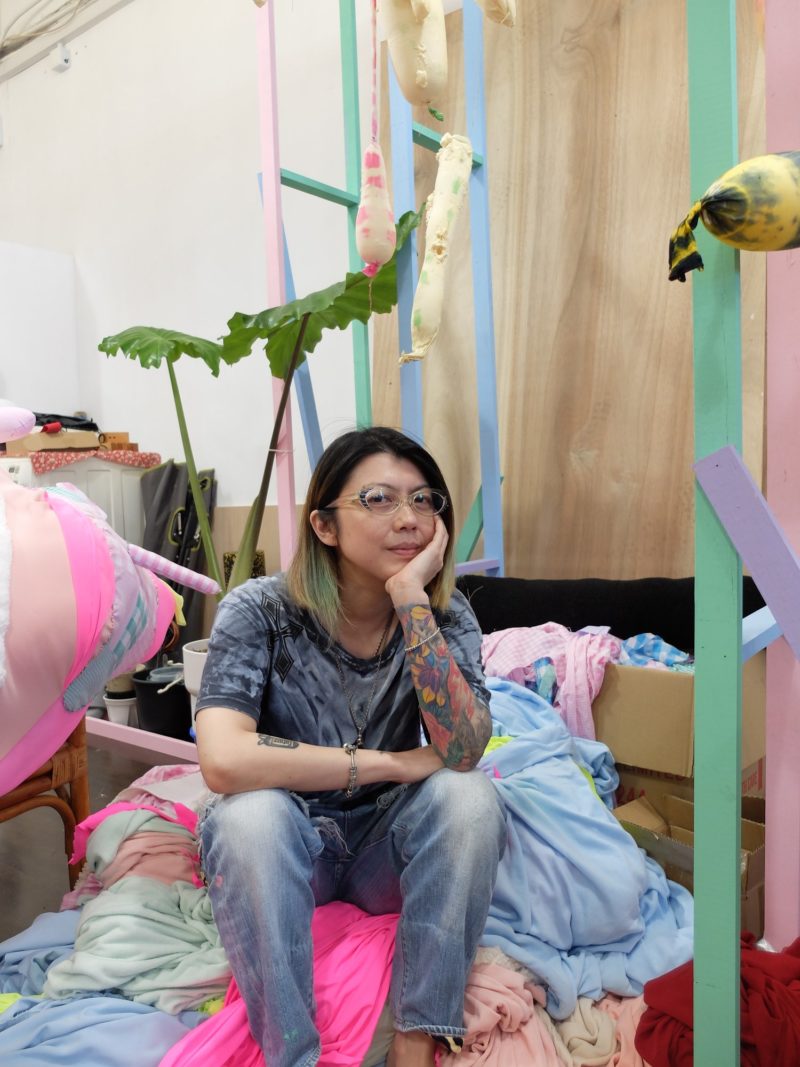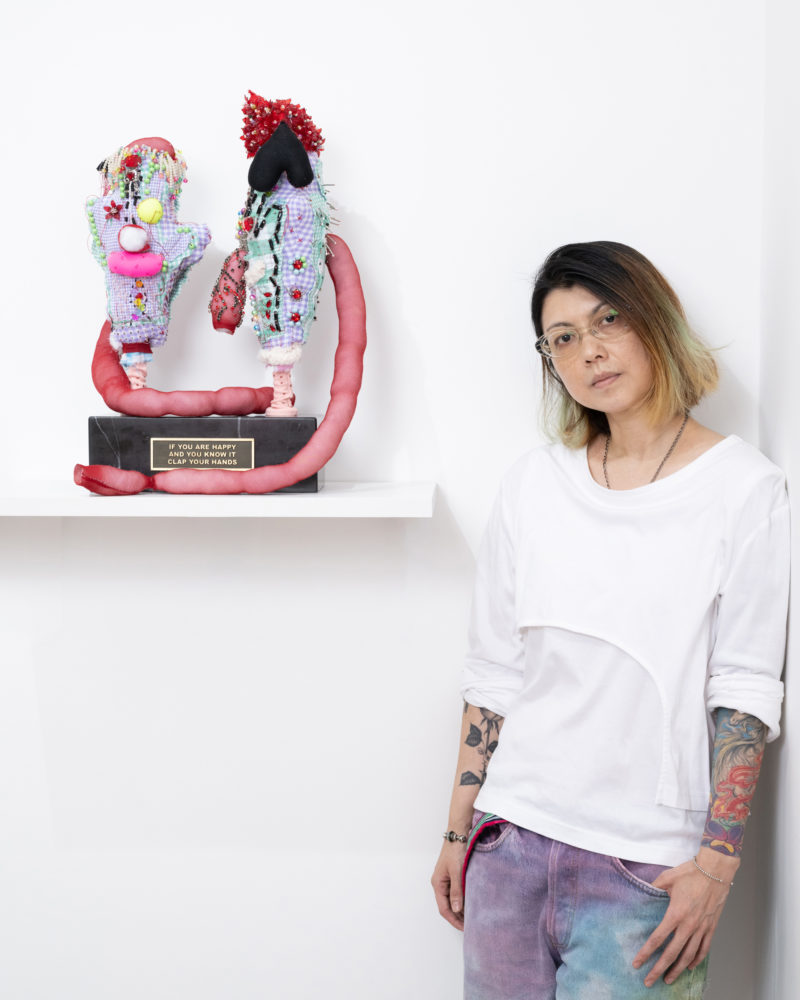The Thread Is Not Straight includes the work of international and locally based artists: Diedrick Brackens, Cristina Camacho, IV Chan, Marie Hazard, Ip Wai Lung, Judy Ledgerwood, and Josie Love Roebuck who all work innovatively within the media of textile and painting to show a complex array of personal and political narratives.
The use of textile, material and thread has experienced a resurgence in contemporary art as a means of exploring identity, heritage, abstraction and the subversion of mainstream art traditions. Denny Dimin Gallery has had an ongoing investigation into the legacy of the Pattern and Decoration movement, which started to explore these themes in the 1970s and 80s with one of the included artists, Judy Ledgerwood as an early proponent. The P & D movement celebrated the artist and media which were slighted by the art world at the time. The work made by affiliated artists such as Ledgerwood, referenced fabric design, quilting, embroidery and other art forms deemed to have more associations with craft. Through The Thread Is Not Straight, Denny Dimin Gallery continues to exemplify how global artists use textile, thread, and associated media to disrupt notions of perfection, gender, body, abstraction and objecthood.
Judy Ledgerwood, whose paintings, Chanteuse, 2021, Coloratura, 2021, Prima Donna, 2021 and Contralto, 2021 feature in the exhibition, has become a reference point and inspiration for artists who want to redefine parameters of art and abstraction under traditional gendered codes. Ledgerwood’s decorative forms challenge the stereotypical approaches to painting. Her practice considers domestically created work by women, utilizing diamonds, quatrefoils, flora, and seed-like shapes within triangles to represent ciphers symbolic of feminine power.
Queering the material in subverting its use and placing it in the forum of supposedly high culture is a starting point for artists examining otherness within their work. Diedrick Brackens focuses on weaving with cotton to highlight the black historical association with that material. The various techniques in his practice such as quilting are akin to a conceptual assemblage of history showing a legacy of his personal heritage and that of his home nation of the United States. Ip Wai Lung takes a look at the wider social discourse of control set by normative expectations of how we look, spend our leisure time and how that informs our sense of self. In his piece Resistance is futile (Linen/Dumbbell), 2022, Ip Wai Lung uses different materials to wrap and bind dumbbells. The process and end result is set to simultaneously call to mind the Chinese heritage of foot binding as well as what is deemed to be acceptable standards of beauty and health across a Western society.
The tactile process of sewing informs how Josie Love Roebuck encounters identity – both her own and others. She associates the act of putting needle to material with putting pen to paper, but the innate hands on quality allows her personal experience to be heightened. This personal interaction gives many of the featured artists the ability to immerse themselves in the narrative behind the work. Marie Hazard, who uses weaving as her method of creating work, looks to the practice as a means of uncovering the history of her selected textile and its origins. It also opens the work to the concept of labour and cost of this physically intensive art form. Like Brackens, her purpose is to uncover the origin stories of the material, as the process allows her to meditate over these narratives through the act of making the work.
Several of the artists featured in The Thread Is Not Straight challenge the gendered female association with material, textile and thread, Cristina Camacho and IV Chan use these associations to explore their own female identity, bodies and relationships. Camacho adds layers of precise acrylic paint in painstakingly accurate symmetry before cutting into the shapes allowing the canvas to fall and flay where it pleases. Her intention is to both give life to the painting with its own sense of governance and to start to mirror parts of the body such as skin, the heart, the vagina and vulva each of which hold strong female association and ownership, yet are equally governed by predefined codes of perfection. IV Chan examined similar ideology in her early practice creating soft anamorphic material sculptures which has since evolved to include more childlike elements and fabrics which relate to personal female histories pertaining to her family and origins. The imperfection of her use of thread, allows the material to be the controlling factor, unleashing the memories like a stream of consciousness. The sound elements within some of her larger sculptures bring further life to the material.
The materiality of these works allows for a more visceral interaction to both the works themselves and the themes which lie underneath. By using the Pattern and Decoration movement as a blueprint we find ourselves in a time where artists are rebelling against the staid norms that have dominated the cultural landscape and those who were traditionally on the periphery are now challenging the predefined codes of what is normal or “straight”.
丹尼迪明香港畫廊欣然呈獻「綫紋不直」(The Thread Is Not Straight) , 群展將於 9 月 10 日至 10 月 29 日舉行 , 並於 9 月 10 日 (星期六) 下午 4 點至 6 點舉行開幕酒會。
展覽《線紋不直》將攜手本地以及國際藝術家包括 Diedrick Brackens、Cristina Camacho、陳⼦ 雯、Marie Hazard、葉惠龍、Judy Ledgerwood 和 Josie Love Roebuck。他們的藝術作品都積極創新地運用了紡織和繪畫作為媒介,以展示一系列複雜的個人和政治敘述。
紡織、材料和線的運用在當代藝術中經歷了一次復興,並成為探索身份、傳承、抽象和顛覆主流藝術傳統的一種方式。丹尼迪明香港畫廊一直在對圖案和裝飾運動(The P & D Movement) 進行研究,此運動在一九七零年代和八零年代便開始探索以上主題,而本展其中一位藝術家 Judy Ledgerwood 也是運動早期的倡儀者。圖案和裝飾運動擁抱了當時被藝術界忽視的藝術家和媒體。 Ledgerwood 等附屬藝術家的作品參考了面料設計、絎縫、刺繡和其他被認為與工藝息息相關的藝術形式。通過 「綫紋不直」,丹尼迪明香港畫廊繼續展示了全球藝術家如何使用紡織品、線和相關媒介來顛覆完美、性別、身體、抽象和客體的概念。
Judy Ledgerwood在本次展覽中將呈現她創作於2021年的四幅最新作品,《Chanteuse》、《Coloratura》,《Prima Donna》,和《Contralto》。成為希望在傳統性別代碼下重新定義藝術和抽象的藝術家的參考和靈感。 Ledgerwood的裝飾形式挑戰了刻板的繪畫方法。她的實踐參考了在傳統家庭的女性的創作,利用三角形內的鑽石、四葉草、植物和種子狀的形狀來代表象徵女性力量的密碼。
對這些材料進行酷兒化,顛覆其用途,並將其置於所謂的高尚文化討論中,是藝術家審視其作品中差異性的起點。 Diedrick Brackens 專注於用棉花編織,以突出黑人與這種材料的歷史關聯。在他創作中使⽤的各種技術,如絎縫就是一個類似於將歷史整合的概念,由此展⽰了他個⼈以及他的祖國美國的⽂化傳承和融合。葉惠龍著眼於更廣泛的關於控制的社會話語,這些話語受正常規範和期望所設定,由我們的外貌、以至我們如何度過閒暇時間,並影響我們的自我意識。在他的作品《抵抗是徒勞的(亞麻/啞鈴)》(2022)中,葉惠龍使用不同的材料來包裹和捆綁啞鈴。這過程和最終結果讓人想起中國纏足的傳統以及西方社會公認的美麗和健康標準。
縫紉的觸覺過程告訴了Josie Love Roebuck 該如何處理多重身份之間的邂逅 — 自己和他人的。她將把針放在材料上與把筆放在紙上的行為聯繫起來,與生俱來的親手質感讓她的個人體驗得到了提升。而這種個人互動使許多在展中的藝術家能夠沉浸在作品背後的敘述。 Marie Hazard 使用編織作為她的創作方法,她將這種做法視為揭示她選擇的紡織品的歷史及其起源的一種方式。它還展示了這種體力密集的藝術形式中有關於勞動和成本的概念。和 Brackens 一樣,她的目的是揭示材料的起源故事,因為這個過程允許她通過製作作品的行為來沉思這些敘述。
「綫紋不直」中的幾位藝術家挑戰了女性與材料、紡織品和線的性別關聯,Cristina Camacho和陳子雯使用這些關聯來探索自己的女性身份、身體和及其關聯。Camacho在作品切割成形狀之前添加了的丙烯塗料層,以精確的對稱性使畫布可以隨心所欲地掉落和飄動。她的意圖是既賦予這幅畫屬於自己的治理意識,並且反映身體的某些部位,如皮膚、心臟、陰道和外陰,以上都具有強烈的女性關聯和擁有權,但同樣受到世俗預先定義的完美所支配。陳子雯在她早期創作的柔軟變形雕塑中也探索了類似的意識形態,這些雕塑後續的演變包含了更多童趣元素和織物,後添加的元素與她的原生家庭、起源和女性歷史有著密切的聯繫。她使用線的不完美,讓材料成為決定因素,像意識流一樣釋放記憶。她的一些大型雕塑中的聲音元素也為材料帶來了更多的生命力。
這些作品的物質性允許我們與作品本身和其主題進行更發自內心的互動。通過將圖案裝飾運動作為藍圖,我們發現自己正處於一個藝術家正在反抗受古板規範主導的文化景觀的時代,而那些歴史上處於邊緣地位的人現在正在挑戰預先定義的正常或“直”的概念。
丹尼迪明畫廊地址位於黃竹坑道42號 利美中心 612, 香港。營業時間為禮拜三至禮拜六,中午12:00 至 下午6:00。
銷售和媒体垂詢請聯繫 ([email protected])
Please join us for the opening reception Saturday, September 10th, 4-6 pm.

IV Chan’s artistic interests are rooted in the complexity of the human body and the mind.

The performance continues IV Chan’s ideas on the formation of identity in childhood, with the focus on the complex relationship arc between the child and its immediate surroundings including its objects, environment, and mother figure.
“The Thread Is Not Straight” at Denny Dimin Gallery, Hong Kong includes the work of international and locally based artists: Diedrick Brackens, Cristina Camacho, IV Chan, Marie Hazard, Ip Wai Lung, Judy Ledgerwood, and Josie Love Roebuck.
Three-minute exhibition walkthrough led by gallery partner Katie Alice Fitz Gerald.